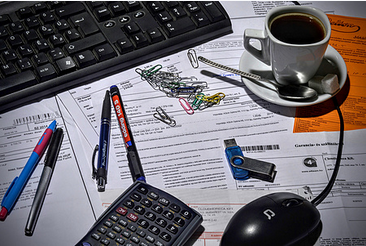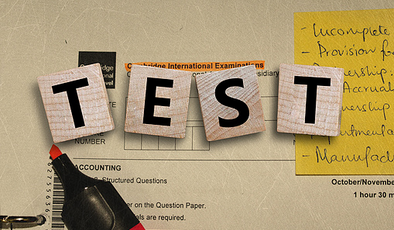ACA Accounting知识点(上)
 a.Accounting is a way of recording,analyzing and summarizing the transactions of an entity. Transactions are recorded in the books of original entry.Chapter 3 Transactions are then analyzed and posted to the ledgers.Chapter 4 Finally,the transactions are summarized in the financial statements.Chapter 5 b.users of financial information and objectives Study Manual p2-3 c.Regulation of accounting(GAAP,Legislation,IFRS,UKGAAP)Study Manual p6-7 d.Introduction to some main financial statements Study Manual p9-11 e.Qualitative characteristics of useful accounting information *Fundamental(Relevance,faithful representation) *Enhancing(Comparability,Verifiability,Timeliness,Understandability) f.Accounting concepts and conventions QB Chapter 1 T3,5 (fair presentation,going concern,accrual basis,consistency,materiality and aggregation,offsetting,business entity concept,historical cost convention) g.fundamental principles QB Chapter 1 T20 (Integrity,objectivity,professional behavior,confidentiality,professional behavior) h.Category of business entities and their introduction QB Chapter 1 T6 (Sole trader,partnership,LLP) 2.Accounting equation Chapter 2 Elements of financial statements(*5):Asset,Liability,Equity,Income,expense QB Chapter 2 T10 Basic accounting equation:Assets=Liability+Equity Profit=Income-expense Expended accounting equation:Asset+Expense=Liability+Equity+Income QB Chapter 2 T1 *The effect of a transaction on the accounting equation.QB Chapter 2 T5,6,7,8,9 3.Recording the transactions (1)Category of source documents and their usage QB Chapter 3 T13 (Invoices,credit note,settlement of credit transactions) P.S Delivery note,debit note,delivery note and good received note are not source of documents (2)Original entries(SDB,PDB,Cash book,Petty Cash book,payroll,journal) QB chapter 4 T8,9,10 P.S SDB and PDB are only used to record credit sales or purchase. Cash book is used to record cash transaction. VAT is followed by the transaction.eg.Credit sales VAT is recorded in SDB 4.Double entry system a.Dual effect of a transaction.Study Manual p83 b.Debit and Credit Study Manual p83-84 QB Chapter 4 T1,2,3,4 5.Analyzing of some transactions (1)Sales Source documents→Cash Book(Paid by cash)→Dr.Cash Cr.Sales revenue Cr.VAT →SDB(Credit sales)→Dr.Trade Receivable Cr.Sales revenue Cr.VAT (2)Purchase Source documents→Cash Book(Paid by Cash)→Dr.Purchase Dr.VAT Cr.Cash →PDB(Credit Purchase)→Dr.Purchase Dr.VAT Cr.Trade payable (3)Return goods to customers Credit note→Cash Book→Dr.Sales Revenue Cr.Cash →SDB→Dr.Sales Revenue Dr.VAT Cr.Trade Receivable 6.Petty Cash&Petty Cash System QB Chapter 3 T3,11 Many businesses keep a small amount of petty cash to make occasional small payments in cash. Imprest system:The amount of petty cash is kept at an agreed sum of float. 企业的备用金一般控制在一个固定的数额,当备用金低于预设的固定数额时,在每一次花费后应定期从银行账户中top up。 Dr,Petty Cash Cr.Cash at bank 7.Payroll QB Chapter 3 T1,5 Definition:The book of original entry for recording staff costs Formula for the calculation: Gross pay=net pay+deductions Deductions=PAYE income tax+Employee’s NI+employee’s pension contributions 8.Capital items Capital expenditure/revenue Chapter 1~non-current asset Chapter 10 (1)Capital expenditure and cost of a non-current asset QB Chapter 1 T1,2,3 Definition:expenditure which results in a.acquisition of long-term assets/non-current assets b.an improvement or enhancement of their earning capacity Examples:purchase of a new PC for an accountant The cost of a non-current asset includes many factors.Study Manual p255 QB Chapter 10 T15 (2)calculation for a non-current asset It is not charged as an expense,but appears in the SFP as a long-term asset Depreciation is used to write off the capital expenditure gradually over time. *Carrying amount=cost of the asset–accumulated depreciation QB Chapter 10 T1/2/17 Calculation: a.(Cost–residual value)/useful life-Straight line QB Chapter 10 T b.a percentage of the brought forward carrying amount–Reducing balance QB Chapter 10 T5 (3)accounting for the depreciation Dr.Depreciation expense Cr.Accumulated depreciation (4)part-exchange and disposal QB Chapter 10 T3/4/11/13/14 Disposal proceeds>carrying amount→profit Disposal proceeds<carrying amount→loss 来源:于濮铭,微信号:Puming_Paddy-Yu,由中国ACA网【www.aca.cn】综合整理发布,若需引用或转载,请注明来源! |






